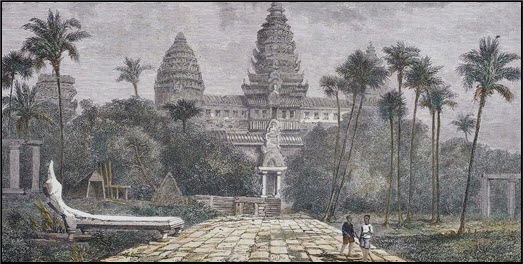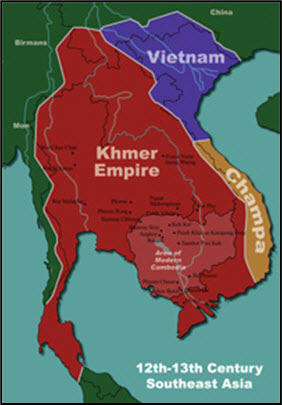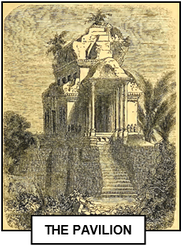


xxxxxWork on the temple Angkor Wat, one of the greatest monuments of the Khmer Empire, was begun in 1113 and took nearly 50 years to complete. The world's largest religious structure, its vast compound is 2.5 miles in circumference. The temple itself is situated on the highest of three courtyards, built upon a huge stepped pyramid and with a central tower over 200 feet high. The Khmers settled along the Mekong River in the 6th century. Their capital Angkor, established about 880, developed into a city of magnificent shrines, palaces and temples, including Angkor Wat. But hostile neighbours attacked the Empire and sacked Angkor in 1177. It fell into ruins and its remains were not discovered until 1863. As we shall see, in 1181 (H2), the Khmers recovered under Jayavarman VII and he rebuilt their capital at Angkor Thom. Their empire survived until 1434.
 xxxxxWork on Angkor Wat (meaning the Temple of Angkor), one of the greatest monuments of the Khmer Empire, was begun in 1113 and took nearly fifty years to complete. Commissioned by the then king of Khmer, Suryavarman II, as his funeral shrine, it is regarded today as the world's largest religious structure. The temple compound is some 1,600 yards square and is surrounded by a moat about 20 yards wide and 2.5 miles in circumference. The great temple itself is situated in the highest of three courtyards, and built upon a huge stepped pyramid. A central, bell-
xxxxxWork on Angkor Wat (meaning the Temple of Angkor), one of the greatest monuments of the Khmer Empire, was begun in 1113 and took nearly fifty years to complete. Commissioned by the then king of Khmer, Suryavarman II, as his funeral shrine, it is regarded today as the world's largest religious structure. The temple compound is some 1,600 yards square and is surrounded by a moat about 20 yards wide and 2.5 miles in circumference. The great temple itself is situated in the highest of three courtyards, and built upon a huge stepped pyramid. A central, bell-
 xxxxxThe Khmer Empire came into existence some time in the sixth century, the first settlements being sited along the Mekong River. In about 880 the Khmers established their capital at Angkor -
xxxxxThe Khmer Empire came into existence some time in the sixth century, the first settlements being sited along the Mekong River. In about 880 the Khmers established their capital at Angkor -
xxxxxBut the Khmers  were not without enemies, and these included the Cham and the Thai. The constant incursions of the Chams from central and southern Vietnam eventually turned into an invasion. They sacked Angkor in 1177 and the temple was virtually abandoned. The old complex slowly but surely fell into ruins. Soxdense was the jungle that eventually covered these magnificent remains, that it was not until the 1850s that they were discovered by the French naturalist Henri Mouhot (1826-
were not without enemies, and these included the Cham and the Thai. The constant incursions of the Chams from central and southern Vietnam eventually turned into an invasion. They sacked Angkor in 1177 and the temple was virtually abandoned. The old complex slowly but surely fell into ruins. Soxdense was the jungle that eventually covered these magnificent remains, that it was not until the 1850s that they were discovered by the French naturalist Henri Mouhot (1826-
xxxxxAs we shall see, the Khmers survived under their outstanding leader Jayavarman VII, who came to power in 1181 (H2). He rebuilt their capital on a new site nearby called Angkor Thom (Great Angkor), but in the thirteenth and fourteenth centuries constant incursions by the Thais undermined the Empire's dominance and led to its downfall in 1434.
xxxxxIncidentally, the Khmers were fierce fighters and were renowned for their use of elephants in battle. The animals were clothed in chain mail or thick bamboo, had blades fitted to their tusks, and carried two or three well-
Acknowledgements
Angkor Wat: by the French naturalist and explorer Henri Mouhot (1826-
ANGKOR WAT 1113 (H1)
Including:
The Khmer Empire




H1-